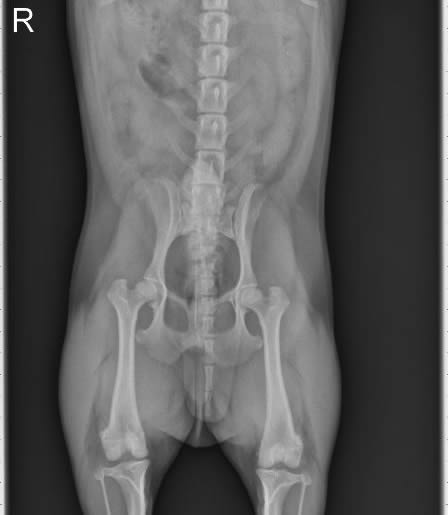Syringomyelia (SM) is a serious health problem that affects a number of small dog breeds, one of which is the Chihuahua. Unfortunately, very few owners are aware of this condition and oftentimes mistake its symptoms for allergies or other issues. As a result, Chihuahuas suffering from SM aren’t given the treatment and/or medication they require. Whether you believe your Chihuahua is affected by this condition or not, it’s important to understand what SM is and what the proper course of treatment is if your Chihuahua develops it.

According to the Chihuahua Club of America, SM began showing up in the Chihuahua bloodline in 2006. A purebred long-coat Chihuahua named Deerus Flashmoon was the first to be officially diagnosed with SM. Since then, numerous Chihuahua organizations and veterinarians have worked to educate owners on this increasingly common condition. Although it’s not considered a common condition, SM can result in result in some painful symptoms and even life-threatening complications.
What Is Syringomyelia?
Syringomyelia (SM) is a condition where fluid-filled sacs develop around the spinal cord where it connects to the brain. In a normal Chihuahua, the cerebrospinal fluid (CSF) circulates to and from the brain with ease. However, those suffering from SM tend to have some form of obstruction preventing the flow of CSF; therefore, it pools up in the spinal column where it forms these fluid-filled cavities.
While it’s most commonly associated with small dogs, the fact is that any breed can develop SM at any given time in their life. One such small dog breed, the Cavalier King Charles Spaniel, is known for its high risk of suffering from SM. In fact, some estimates suggest that over 90% of CKCS’ will develop the condition at some point in their life. This is a shocking statistic to say the least, but early detection and treatment can help your canine deal with this horrible condition.
Causes
SM is generally caused when the top of the spinal column is blocked, preventing the normal flow of spinal fluid to the brain. When this occurs, the characteristic sacs begin to develop and fill with fluid. You have to remember that spinal fluid isn’t meant to remain in the spinal column. In healthy canines, and people for that matter, it travels back and forth to the brain. Dogs suffering from SM have a blockage that prevents their spinal fluid from moving, and as a result, it causes the fluid-filled sacs to pop up. It may only be a single sac, or it can be as many as half a dozen.
One of the most common causes of SM in Chihuahuas is a malformation or deformity where the brain is larger than the skull, such as Chiari-like malformation (CM). Typically, the brain of Chihuahuas suffering from CM will push up against the narrow cavity of the spinal column, resulting in a natural blockage. When the brain is pressed hard enough, it becomes air-tight, preventing the flow of spinal fluid to and from the brain. Some Chihuahuas are born with SM, while others develop it later into their adulthood.

Symptoms
Symptoms can vary from a minor itchy feeling to excruciating pain and discomfort. It really depends on how severe your Chihuahua’s SM condition is, as well as their body’s reaction. With that said, here are some of the most common side effects associated with Syringomyelia:
- SM is also known as the neck scratching disease because dogs suffering from it will scratch their neck excessively.
- Pain around the neck and head (generally worse at night).
- Sensitivity to extreme cold or hot temperatures.
- Spinal scoliosis (spine bends in an abnormal shape).
- Shaking and shivering.
- Yelping for no visible reason (sign of pain).
- Holding one or both of their back legs up off the ground.
If you’ve noticed your Chihuahua exhibiting one more of the symptoms previously mentioned, schedule an appointment with your veterinarian immediately. They will perform a more thorough examination of your Chihuahua to determine whether further investigation is required. Currently, the only way to 100% identify SM is through a magnetic resonance imaging (MRI) scan. Some veterinarians may have these devices in their office, but chances are you’ll be referred to a veterinary specialist, such as a neurologist.
Treatment

There are a couple of different forms of treatment available for Chihuahuas suffering from SM, and only an experienced veterinarian can tell you what course of action is best for your specific Chihuahua’s condition. It’s important to sit down and talk with your veterinarian to weigh the pros and cons associated with each treatment option. Only then can you make an educated decision to help your Chihuahua’s condition improve.
In recent years, Chihuahuas and other dogs suffering from SM have been given drugs that inhibit the production of cerebrospinal fluid formation with limited success. Drugs like Prilosec result in lower spinal fluid production, which in theory would help to treat SM. The problem, however, is that use of fluid-inhibiting drugs only works as a short-term treatment option, and it also comes with its own fair share of unpleasant side effects.
Pain management is oftentimes the recommended choice of action by veterinarians. As long as your Chihuahua’s condition isn’t worsening, medication to help them deal with the pain may be advised. Non-steroidal anti-inflammatory drugs (NSAIDs), such as Rimadyl and Metacam, are useful for both reducing pain and inflammation associated with the condition. Opiates may also be given when traditional NSAIDs aren’t enough to subside their discomfort.
Lastly, there are surgical procedures aimed to treat SM and the unpleasant side effects it creates. Typically, surgical operations are only recommended for Chihuahuas with severe and/or late-stage SM, as it’s usually accompanied by extreme pain and discomfort. The primary goal of surgery is to release pressure on the foramen magnum so that spinal fluid can easily flow to and from the brain. This is oftentimes done by removing pieces of hypoplastic occipital bone or the surrounding area. Once the bone is removed, it should open up just enough space for the spinal fluid to flow freely.
References:
https://vcahospitals.com/know-your-pet/syringomyelia-and-chiari-like-malformation
https://asap.org/wp-content/uploads/2014/11/ASAP-Fall-2014-Connections-with-Kids-newsletter.pdf
Who ever wrote this, Thank you!! My baby has all the symptoms, to a T. I have already took him to the vet even, but they just assumed it was arthritis. This sets my mind at ease at least.
I wonder if Vaccines have any part to play with all of these sick pets? Worth some looking into…
My Prissy just had surgery for this condition. What led us to this point all started a month ago when she was put under anesthesia for her dental cleaning. Brought her home and immediately could not bear weight on her hind legs. The runny nose and sneezing and snotting symptoms were there also. Not convinced that the Dr that performed the dental didn’t do something to unleash the hell we have dealt with for the last month. She was PERFECT before that🤬. She is still at a university hospital and it is still unknown if she will walk again.
Hello, I have a 7 month old chihuahua and she has a lot of the symptoms but no pain that I have noticed. But is she too young to get this? Or is there not a age limit?
Hello I have a male chihuahua and he is just over a year now. He has all of the symptoms minus the pain. He wi be going infor that but my question is would a lump develop in what wpuld be considered a humans tonsil area?
My Chihuahua is in pain, 15 yrs old hurt hip when he was 10. Arthritis set in. I give him baby aspirin bayer. Tremendously, vet can do nothing but pain meds. He is so happy and full off life. He is my little man. Am I doing the right thing?
My Lillybell has all the signs so I will take her asp. My question is how old is too old she 10yrs.
Could brief seizure activity be linked to this disease? My chihuahua is experiencing some of these symptoms and also had his first (and so far only) 10 second seizure 10 days ago. Thank you!
FYI our 7 year old female chihuahua was diagnosed with this condition. She was having mini seizures so we sent her for a brain MRI. That is how it was diagnosed. I was surprised that seizures was not n this list of symptoms.
Question: What is the success rate for “surgery to release pressure on the foramen magnum” for Chihuahuas with severe/late stage SM? If we go ahead with this for our Chihuahua, can we anticipate a successful outcome, our Chihuahua back to normal?
Hey Gordon,
Most surgical veterinarians report a success rate of approximately 80% with this procedure. However, some Chihuahuas may relapse with syringomyelia in the future due to the formation of scar tissue. Talk with your vet to gauge their clients’ success with this procedure.